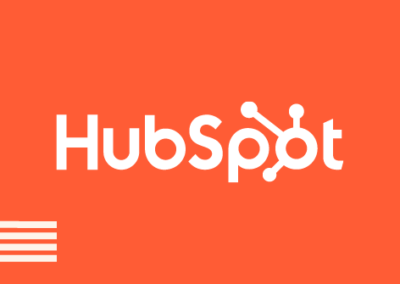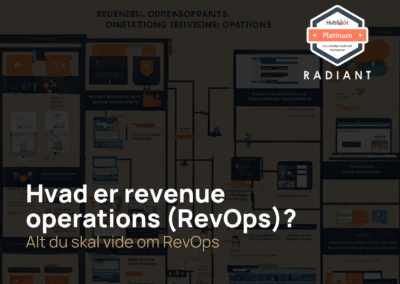When it comes to choosing a CRM system, it’s important to compare CRM systems and get an overview of which solution best meets your marketing, sales automation and contact management needs.
Similarly, you need to consider whether you operate in B2B including SaaS, manufacturing, etc. – or whether you work with B2C, such as e-commerce or similar. This defines which CRM systems you have to choose from.
In this guide, we will briefly go through what a CRM system is and what are the most important benefits of a good CRM system. Next, we will focus on the CRM system HubSpot One of the most popular CRM solutions on the market. We will explore what makes HubSpot so popular and how it performs compared to other CRM systems.
Read more:“What is HubSpot“
What is a CRM system?
CRM stands for Customer Relationship Management and is a system that helps companies manage their customer relationships and improve sales and marketing activities. A CRM system allows businesses to organize and store customer data, track sales processes, manage customer support and generally improve the customer experience.
Read more: “What is CRM?“
What are the main benefits of CRM systems?
CRM systems are an important technology that helps businesses manage their customer relationships more effectively. By implementing a CRM system, companies can achieve a number of important benefits.
One of the key benefits of a CRM system is that it allows businesses to gain a more holistic and comprehensive understanding of their customers. CRM systems provide a centralized platform where all customer data can be collected and analyzed. Among other things, this enables companies to create in-depth personas that can inform their marketing and sales strategies.
By having access to all relevant customer data, businesses can also identify and capitalize on new opportunities for cross-selling or upselling.
HubSpot vs. Salesforce
Among the many CRM systems on the market, HubSpot and Salesforce are two of the most popular choices. While Salesforce is a more established CRM, HubSpot has emerged as a strong contender in recent years due to its user-friendly interface, affordable pricing options and all-around solution.
Ease of use
HubSpot’s user-friendly and intuitive design makes it easier for you and your business to get started and optimize your processes. In contrast, Salesforce requires a more technical background and is not as user-friendly in its design.
Price
HubSpots has a free version and affordable payment plans that make it more accessible compared to Salesforce’s pricing model. Although Salesforce starts its pricing from as low as $25 per user per month, there’s a reason HubSpot is considered the preferred choice for businesses up to 250 employees – especially those that are growing.
Integration options
Both HubSpot and Salesforce offer a range of integrations with other tools and platforms. Both CRM systems have 1,000+ integrations, making them both a great choice in this area.
Customer support
HubSpot’s commitment to customer satisfaction and support will ensure you get the help you need to succeed. Salesforce’s support is known to be more complicated and difficult to navigate.
Overall, HubSpot offers an excellent combination of affordability, ease of use, integration options, customer support, and reporting and analytics tools. This makes HubSpot a better choice for businesses looking to streamline their workflows and expand their customer base.
HubSpot vs. Pipedrive
Pipedrive is an alternative to some of HubSpot’s solutions. Both systems have their strengths, but HubSpot has several advantages that make it a better choice for those who want an all-around CRM system.
All-in-one solution
HubSpot stands out as a comprehensive all-round platform compared to Pipedrive. It provides a range of features that cater to all parts of your organization. While Pipedrive offers a robust CRM, HubSpot not only provides a free CRM, but also lets you add other Hubs for marketing, sales, service and CMS. This makes HubSpot a more comprehensive solution where Pipedrive focuses on sales.
Customization and complexity
One of the key differences between HubSpot and Pipedrive is their approach to customization and complexity. While Pipedrive has a simpler and more straightforward design, HubSpot offers far more options for customization and personalization. Although the complexity of features increases with higher pricing plans, HubSpot ensures they remain user-friendly and offer a superior user experience compared to Pipedrive.
Workflow Automation
When comparing the workflow automation features of HubSpot and Pipedrive, HubSpot’s workflow feature wins. The system provides a super user-friendly way to automate processes and communication across different areas of your organization, not just sales where Pipedrive has its focus.
Reporting and analytics
When it comes to reporting and analytics, HubSpot’s capabilities surpass those offered by Pipedrive. While Pipedrive offers basic reporting features, HubSpot offers more complex and customizable reporting tools.
With HubSpot, you can generate a variety of reports, customize dashboards for easy access and gain insights from the entire sales cycle. If your marketing and service teams also use HubSpot, you can create comprehensive dashboards that track the performance of the entire buyer’s journey, making it a superior choice for in-depth analytics compared to Pipedrive.
All in all, in a way, Pipedrive represents the HubSpot Sales Hub. If you want a solution you can build on, HubSpot should be your first priority.
HubSpot vs. Microsoft Dynamics
Both HubSpot and Microsoft Dynamics offer unique benefits. However, HubSpot stands out as the better choice for you if you’re looking for an all-in-one solution that delivers an easy-to-understand interface, affordable price, integration options and powerful reporting and analytics capabilities.
User-friendly experience
HubSpot provides a more user-friendly experience compared to Microsoft Dynamics. While both platforms offer a wealth of advanced features, HubSpot ensures that the complexity of these features doesn’t impact your user experience.
Powerful and intuitive automation
Both CRM systems have a wealth of automation options. Where they differ is that HubSpot’s design is more user-friendly. This makes it easier to get started with automations in HubSpot. Likewise, HubSpot is a more all-round solution for things like marketing, making it easier for you to perform value-adding automations.
Comprehensive reporting
Both HubSpot and Dynamics 365 offer reporting. Where HubSpot stands out is by offering a much higher ceiling in terms of reporting capacity. In HubSpot, it’s easy to create a variety of reports, view data quality, customize your dashboards for easy access and gain insights from your complete sales cycle, marketing activities and customer service. If you don’t have this need, both CRM systems are great.
Scalability
If you want an all-in-one platform that’s free to start with and has plenty of room to scale in the future, HubSpot is an excellent choice. It’s suitable for both small businesses and entrepreneurs who need a simple CRM, as well as fast-growing teams who want a scalable all-in-one platform. Conversely, if you need a CRM system for a large company (250+ employees), many choose Dynamics 365 from the start because it is considered to be very dynamic and better equipped to meet the complex requirements that come with the size of the company.
Flexibility in pricing
HubSpot’s free CRM gives you access to basic features for sales, marketing and support teams. However, the most valuable features are locked behind paid Hubs that are available at different levels. This allows you to customize your CRM experience based on your business needs and budget, giving HubSpot a competitive advantage.
Overall, both CRM systems have their pros and cons. HubSpot’s all-in-one solution, ease of use, pricing and affordability, integration options, and reporting and analytics capabilities make it a better choice for you unless you have incredibly complex requirements and are already a large established business.
HubSpot vs. Zoho CRM
When comparing HubSpot and Zoho CRM, there are several factors businesses should consider. While both CRM systems have their strengths and weaknesses, there is a difference when you dive in.
Customization
When it comes to customization, both CRM systems have their advantages. Zoho CRM is known for being for the tech-savvy and those who want to build their own module choices. On the other hand, HubSpot, with its user-friendly design, also has a lot of customization options that make both CRM systems a strong choice. It therefore depends on whether you want to design your CRM system yourself with Zoho or if you prefer to go with a scalable solution through HubSpot.
Analytics
Both CRM tools are considered an all-around solution that includes marketing, sales, customer service and operations capabilities. But when it comes to analytics, HubSpot has the advantage of being streamlined and built for you. This makes it easy to get started with analytics as there are a lot of predefined options.
Artificial intelligence
HubSpot is a CRM system that is constantly evolving. HubSpot has shown this by now also offering AI such as Chatspot ai and content assistant. Artificial intelligence is considered to be the new thing when it comes to streamlining and automating tasks. Already, companies are saving countless man-hours on administration by using it, making HubSpot a frontrunner in a new field.
Overall, Zoho CRM may be a good option for some businesses, while HubSpot’s all-in-one solution, customer support, scalability, integration options and reporting are the next level and the serious choice when it comes to CRM. Zoho.
Get the best CRM system with Radiant
At Radiant, we implement and optimize HubSpots on behalf of a number of B2B companies in the Fintech, Professional Services, Saas and Tech verticals. Radiant has the following services within HubSpot:
HubSpot as a Service is a subscription solution that aims to tie all your investments in sales, customer service, operations, marketing and CMS together to create synergies across departments. Radiant invented the HubSpot as a Service category after implementing HubSpot at a number of companies that still had a need for ongoing optimization, maintenance and sparring around their CRM system, and they turned to us. The purpose of HubSpot as a Service is to be the execution and strategic partner that businesses need so that their employees can focus on what they do best without the hassle of their tech stack.
HubSpot implementation is a one-off solution where Radiant executes on finding the right hubs and solutions for you and negotiating the best price, which is possible for us as a HubSpot Platinum Partner. Next, we implement a 360-degree funnel and best practice optimized CRM system in 4 weeks.
Once the CRM system is implemented, tested and optimized for your needs, we also help with segmentation through LassoX and Vainu, as well as implementing the integrations you use – including Leadfeeder, monday.com, LinkedIn and more. Similarly, at Radiant, we’ve teamed up with Plecto to create gamification, employee motivation and data analytics on your sales activities that can be implemented as needed. All in all, Radiant implements the perfect CRM system for you and makes sure you have best practices to work from.




